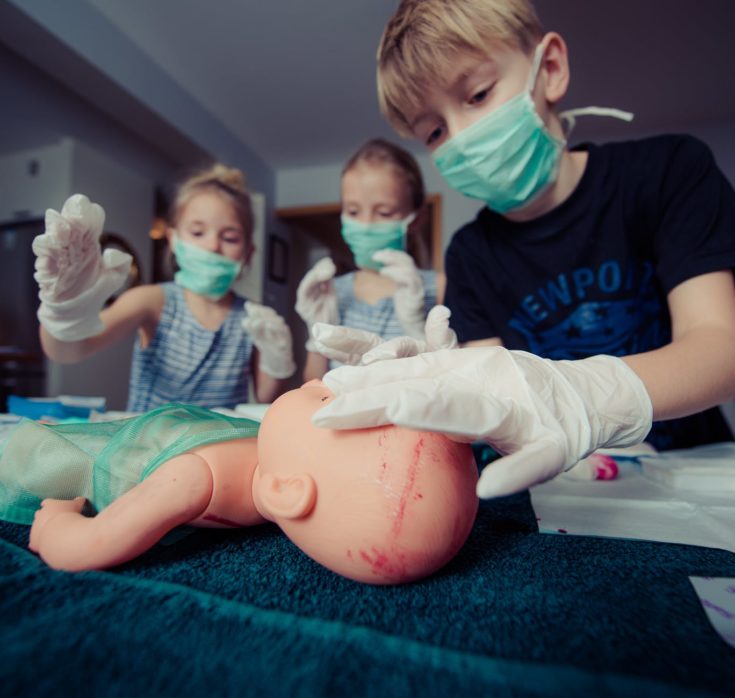Disclosure: This post may contain affiliate links, meaning we get a commission if you decide to make a purchase through our links, at no cost to you. Please read our disclosure for more info.
Those who think that only adults are capable of helping in a case of dire emergency need only to learn the story of young Emma Bazzard. The three-year-old British toddler made headlines last 2015 when she found her pregnant mother unconscious after a bad fall in the house and proceeded to call 999 ambulatory services to convey the problem to paramedics. Emma’s high situational awareness and cool head saved the lives of her mother Catherine and her unborn brother, George, and earned her a bravery award from the South Western Ambulance Service.  Key takeaways from this amazing story are: that even small children may be taught how to behave in situations of grave danger and that the foundations of first aid—which aims to preserve life, prevent further injury, and promote recovery—can be passed on to learners of a young age. But the question is, what kind of first aid-related values and techniques should be bestowed upon children? Is age a factor in learning how to save lives? If you want your child to learn first aid, and are considering enrolling them in a first aid training course in Loganholme or within your home county, at what age and aptitude level should they be?
Key takeaways from this amazing story are: that even small children may be taught how to behave in situations of grave danger and that the foundations of first aid—which aims to preserve life, prevent further injury, and promote recovery—can be passed on to learners of a young age. But the question is, what kind of first aid-related values and techniques should be bestowed upon children? Is age a factor in learning how to save lives? If you want your child to learn first aid, and are considering enrolling them in a first aid training course in Loganholme or within your home county, at what age and aptitude level should they be?
Here’s a primer on the first things you should be imparting to your children, the expectations you should have for first aid training per age group, and how to go about enrolling your child in a first aid class. A Helping Mindset for Children of All AgesBefore formal first aid training begins for your child, it’s important for them to have learned certain habits and perspectives that can be life-saving in nature. These are the “survival tools” that your child can equip themselves with once they segue into proper first aid training and will serve as the perfect foundation for successful first aid execution. Some things you can teach your children ages 13 and below are:
-
- How to keep calm when something seems out of the ordinary. Even adults have a hard time staying calm when something disrupts their daily habits. Nonetheless, you should instil in your children the values of being calm, level-headed, and resistant to panic when scary situations arise. Staying calm could prevent the situation from worsening and clears the path for the help on the way.
- Who to call for help and how. Young children can be taught how to use a telephone and to keep relevant numbers. Among these are: the 000 emergency hotline, the number of your city centre, and the numbers of trusted family members or neighbours who can get the aggrieved to a safe place.
- What and where the emergency supplies are. Each household should have its own emergency kit, and this should contain medicines, medical implements, food, water, and energy supplies to last at least 72 hours in a disaster. Tell your children where to access the said kit, how to read the labels, and where they can go in case they need to replenish their supplies.
- How to treat wounds and bruises. Your child or their peers may incur wounds or bruises on the playground or while playing sports. Teach your child how to wash and wipe simple wounds, how to put on a bandage properly, and how to apply hot and cold compress.
When Formal First Aid Training Is Appropriate—and Invaluable
Formal first aid training, on the other hand, involves more than these simple habits. A certified first aid training course—the kind that’s given by a Registered Training Organisation—constitutes modules for treating wounds, burns, fractures, animal stings, and allergic reactions, as well as more complex techniques like CPR. These modules are taught by accredited professionals and are commonly populated by adults who need Continuing Development Points (CPD) for their career. Once they complete these courses, adult students receive Statements of Attainment that are recognised all over Australia.
However, these courses may also issue Statements of Attainment to teenagers from 14 to 18 years old. Secondary school students in the Vocational Education and Training in Schools (VET in Schools) programs need First Aid or CPR certificates to complete their schooling. Certainly, other teenagers may enrol in these courses for leverage in traineeships, apprenticeships, leadership training programs, or community engagement initiatives.
Students younger than 14 can take non-credit first aid classes, but the output of these is a Certificate of Participation, rather than a Statement of Attainment. First aid training organisations typically require a letter or form of parental consent for all students younger than 18 years old.
Parents should consider age-appropriateness and proficiency when enlisting their children in these courses. For example, only children 10 years old and above are likely to have the physical strength to apply the force needed for a chest press in CPR. Another consideration is the sensitivity of the subject matter; some concepts taken up in formal first aid training can be graphic and too heavy for younger children to handle.
Ultimately, as a parent, you’re enjoined to assess what kind of first aid training is suitable for your children based on how physically, mentally, and emotionally prepared the latter are for this advancement. All the same, the preparation to save lives, and to do good to your community, should start now.
Sources:
- http://head2toefirstaid.com.au/2018/04/15/first-aid-teach-children/
- https://www.qaeducation.co.uk/content/importance-first-aid-training-children
- https://www.rd.com/health/wellness/teaching-first-aid-kids/
- https://s3-ap-southeast-2.amazonaws.com/awfawpmedia/wp-content/uploads/2018/10/TA002_ParentConsentForm+v2+Sept+2018.pdf
- https://www.allenstraining.com.au/blog/can-a-course-participant-be-too-young-or-too-old.aspx
- http://www.ivet.com.au/a/74.html
- https://www.dailymail.co.uk/news/article-3372587/Girl-three-given-bravery-award-ambulance-service-making-life-saving-999-call-pregnant-mother-fell-stairs.html
